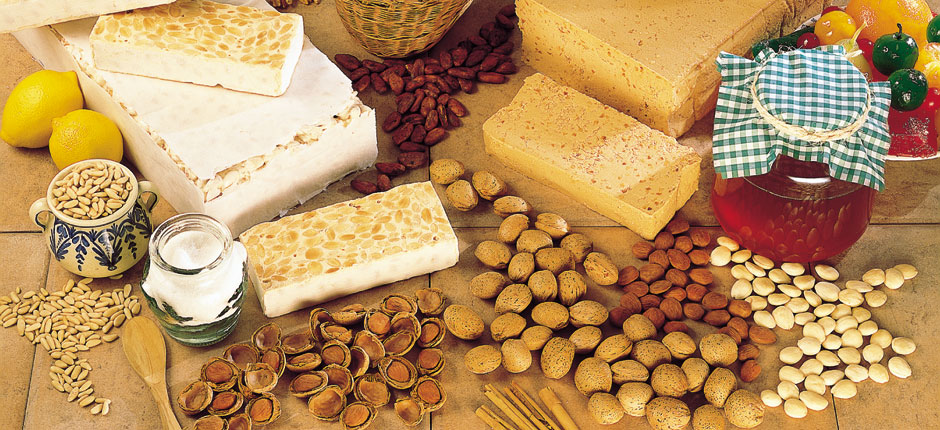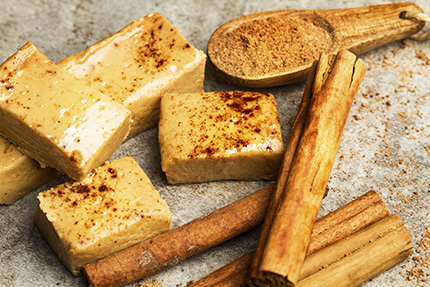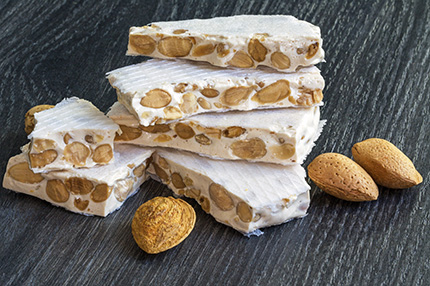
The Nougat is a sweet dough obtained by cooking honey (or sugars) to which peeled and roasted almonds are incorporated. Egg yolk is added to this dough to emulsify. Later this dough is kneaded and given its final rectangular or rounded shape.
The academics place the origin of the turrón in the Arabian península. This theory is based on the treaty “De medicinis et cibis semplicibus” from the XI century which speaks of “turun”. The Arabs brought this dessert to the Mediterranean coast, in particular to Spain and Italy. The Spanish version of the nougat was born in the province of Alicante around the fifteenth century because in the time of Carlos V it was already a famous sweet.
The manufacturing process is authentically traditional and, although modern machinery facilitates its industrial production and guarantees higher quality, the sector continues to be guided by the same old recipe.
The nougat with designation of origin are the Alicante nougat and the Jijona nougat that must follow rigorous and ancestral elaboration processes:

Jijona Nougat elaboration
Peeled almonds are roasted, in rotating cylinders heated on high heat, called "roasters". In a kind of rotary blender, called "mecánica", with a capacity of 50 to 60 kg, a mixture of sugar and honey is cooked on a high heat in the quantities necessary to comply with the specifications of the CRIGPJTA (Regulatory Council of the Protected Geographical Indication).
Once the dough, of what would be the Alicante nougat is obstained, instead of proceeding to its molding, the still hot dough is spreaded manually in sheets of 1 cm approx. thick on tables or cooling surfaces. Once it is chilled, the different sheets are milled in granite mills, thus obtaining a dough, with an appearance already similar to Jijona nougat but with a much bigger grain size (due to the breakage of the almond still too large), which goes through different refine processes in order to get a fine dough.
This dough is introduced into a cauldron of 50 to 60 kg capacity, to go into a second moderate cooking accompanied by a beaten with a mechanical mallet that is incorporated in the previous cauldrons that are known as "boixets", in which through these movements of the boixet, the right compactness of the dough is achieved. Subsequently, if the nougat is granulated, a second quantity of roasted granulated almonds (almond granite) is added. While still hot, this dough is finished off "arrematar" (get the ideal texture - process performed by the Master Turronero) and is molded in drawers, but not coated with wafer.
Due to the large amount of almonds, and the fact that in the Jijona nougats the almonds are grounded, the oil from the almond can be seen in the packaging. The more almonds we use, the more oil we get. Then, the nougat, still hot, rests in the drawers for 24 hours when releases the oil before being cut in bars.
In our case and due to the high percentage of almonds, these drawers are allowed to stand up to 72 hours due to the large amount of oil they exude, an unquestionable parameter of the good quality of the selected almonds .
Alicante Nougat elaboration
The roasting and boiling operations of honeys are similar to the process described when making Jijona nougat. It varies at the end of the process, when diluted egg white is added for whitening until the necessary “ball point” is reached, by evaporation of the added water, when the roasted almonds are added in proportion, according to the qualities to be elaborated, to which it continues a manual turning with shovels of the resulting mass, until obtaining a homogeneous distribution.
While still hot, it is weighed and molded in wafer-covered drawers, with a capacity of about 6 kg. With these 6 Kg blocks, the “Jijonencos” used to travel across Spain.

Nowadays, and due to the appearance of new ways of selling, the nougat can be mechanically cutted when is still warm or cold before its final packing.
Bakery Nougats
To elaborate other traditional nougats, named “Bakery Nougats”, such as the Snow Nougat, the Egg Yolk nougat (toasted or not), the Glazed Fruit Nougat or the Walnuts Nougat, almonds and sugar are also used as main ingredients, to which other differentiating ingredients such as confitted yolk, confitted fruit or dry nuts are incorporated. The difference from the previous protected nougats lies in their elaboration process and is that the almond is not roasted, but once it has been repelled and dried, it is ground very finely in the steel cylinder refiners.
A special case of classic nougats are the ones defined below:
- Nougat a la Piedra: It is a nougat whose elaboration process is similar to the so-called factory nougat, with the only difference that it incorporates roasted almonds instead of raw. The traditional composition of this nougat is: roasted almonds, sugar, lemon rind and cinnamon.
- Terronico: It is similar to Guirlache nougat, but sesame seeds are added to it. It is especially distinguished because the almond is unpeeled.
Source: Wikipedia y Consejo Regulador de Jijona y Turrón de Alicante

